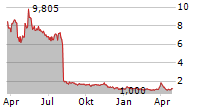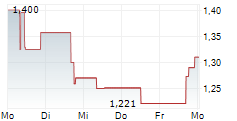
- Iomab-B led bone marrow transplant improved survival in patients with high-risk relapsed or refractory acute myeloid leukemia including those with a TP53 mutation
- Iomab-B safely delivered radiation to the target bone marrow at greater amounts than achievable with total body irradiation while sparing healthy non-target organs and enabled 100% access to bone marrow transplant
- Novel linker technology supports Actinium's Antibody Radiation Conjugate pipeline expansion in solid tumor indications
NEW YORK, June 10, 2024 /PRNewswire/ -- Actinium Pharmaceuticals, Inc. (NYSE AMERICAN: ATNM) (Actinium or the Company), a leader in the development of Antibody Radiation Conjugates (ARCs) and other targeted radiotherapies, today highlighted data from multiple abstracts that were presented at the 2024 Society of Nuclear Medicine & Molecular Imaging (SNMMI) Annual Meeting being held June 8 - 11, 2024, in Toronto, Canada. The presentations featured results from the Phase 3 SIERRA trial of Iomab-B, a CD45 targeting ARC with the Iodine-131 payload, intended for conditioning to prepare patients with active relapsed or refractory acute myeloid leukemia (r/r AML) for a potentially curative bone marrow transplant (BMT). The Phase 3 SIERRA trial enrolled 153 r/r AML patients. Iomab-B achieved the primary endpoint of durable Complete Remission (dCR) with high statistical significance (p<0.0001). Additionally, Actinium's novel linker technology was highlighted in a presentation demonstrating high tumor uptake and in vivo stability in preclinical models with significantly lower kidney and liver uptake compared to standard DOTA linkers.
Actinium's Iomab-B SNMMI presentations and highlights:
Survival Outcomes and Dosimetric Analysis of Iomab-B (131I-apamistamab) Followed by Allogeneic Hematopoietic Cell Transplant for Patients with TP53 Mutated Relapsed/Refractory AML
- 37 patients (24%) enrolled on SIERRA had a TP53 mutation with 27 patients receiving Iomab-B (either through randomization or cross over) and 10 patients on the control arm
- For patients with TP53 mutation who received Iomab-B, the median OS was 5.49 months compared to a median 1.66 months in pts who did not receive Iomab-B (HR=0.23; 95% CI [0.10, 0.52])
- These results support Iomab-B's differentiated mechanism of action to overcome the negative impact of TP53 mutation typically associated with a dismal prognosis in these patients
Exploratory Analysis of Bone Marrow Dosimetry from the Randomized Phase 3 SIERRA Trial of Iomab-B (131I-apamistamab) Prior to HCT in Relapsed/Refractory Acute Myeloid Leukemia
- Iomab-B safely delivers high doses of myeloablative targeted radiation to the diseased bone marrow at greater amounts than what would be achieved with total body irradiation
- Myeloablative doses were safely delivered to patients irrespective of age, performance status and other metrics
- A median of 16Gy of radiation was delivered to the bone marrow while normal healthy organs received significantly less exposure, including the heart (2.6 Gy), lungs (2.5 Gy), small intestine (2.4 Gy), stomach (3.6 Gy), kidneys (4.1 Gy) and the whole body (3.3 Gy)
Mathematical Modeling of Exposure Measurements Following High-Dose Targeted Therapy Using 131I-apamistamab: Analysis From the Large Multicenter Phase III SIERRA Trial
- SIERRA patients received up to 1,030 mCi (range: 300-1,030) of Iodine-131 via Iomab-B
- Iomab-B is administered via a single infusion 12 days prior to BMT
- Data from SIERRA show that the median time for patients to reach the release criteria was 5 days, including in patients receiving greater than 800 mCi
Actinium's Proprietary Linker Technology SNMMI presentation and highlights:
Evaluation of novel DOTA-based linkers for improved targeted radiotherapy delivery to solid tumors
- Novel linkers showed significantly lower kidney and liver uptake compared to standard DOTA linkers
- SPECT/CT imaging showed high tumor uptake and in vivo stability in preclinical models
- Successful design, efficient conjugation and pharmacological properties support further advancement of these novel linkers
- Actinium has two wholly owned U.S. patents covering its novel bifunctional linker technology with each having a patent term extending into 2043 and a pending international patent application
Sandesh Seth, Actinium's Chairman and CEO, said, "At this year's SNMMI, we are proud to highlight Actinium's broad ARC pipeline and capabilities. Building on our leadership position in hematology focused ARCs through Iomab-B and Actimab-A, we are excited to highlight the potential to treat patients with high-risk relapsed or refractory AML and overcome TP53 mutations or extensive prior therapy including Venetoclax. Hematology represents an area with potential for significant growth for the field of nuclear medicine and there is great excitement from the community around our efforts. Consistent with our vision to build a leading specialty radiotherapeutics company, we are also eager to highlight our novel linker technology for solid tumor ARCs. Finally, SNMMI provides the opportunity to showcase our proprietary Actinium-225 cyclotron-based manufacturing technology that has the potential to produce highly pure medical grade Actinium-225 at a scale and cost that is not currently achievable, which has been met with great enthusiasm given the industry emphasis on Actinium-225 supply."
About the SNMMI Annual Meeting
The SNMMI Annual Meeting is recognized as the premier educational, scientific, research, and networking event in nuclear medicine and molecular imaging. The four-day event, taking place each June, provides physicians, technologists, pharmacists, laboratory professionals, and scientists with an in-depth view of the latest research and development in the field as well as providing insights into practical applications for the clinic.
About Actinium Pharmaceuticals, Inc.
Actinium develops targeted radiotherapies to meaningfully improve survival for people who have failed existing oncology therapies. Advanced pipeline candidates Iomab-B (pre-BLA & MAA (EU)), an induction and conditioning agent prior to bone marrow transplant, and Actimab-A (National Cancer Institute CRADA pivotal development path), a therapeutic agent, have demonstrated potential to extend survival outcomes for people with relapsed and refractory acute myeloid leukemia. Actinium plans to advance Iomab-B for other blood cancers and next generation conditioning candidate Iomab-ACT to improve cell and gene therapy outcomes. Actinium holds more than 230 patents and patent applications including several patents related to the manufacture of the isotope Ac-225 in a cyclotron.
For more information, please visit: https://www.actiniumpharma.com/
Forward-Looking Statements
This press release may contain projections or other "forward-looking statements" within the meaning of the "safe-harbor" provisions of the private securities litigation reform act of 1995 regarding future events or the future financial performance of the Company which the Company undertakes no obligation to update. These statements are based on management's current expectations and are subject to risks and uncertainties that may cause actual results to differ materially from the anticipated or estimated future results, including the risks and uncertainties associated with preliminary study results varying from final results, estimates of potential markets for drugs under development, clinical trials, actions by the FDA and other governmental agencies, regulatory clearances, responses to regulatory matters, the market demand for and acceptance of Actinium's products and services, performance of clinical research organizations and other risks detailed from time to time in Actinium's filings with the Securities and Exchange Commission (the "SEC"), including without limitation its most recent annual report on form 10-K, subsequent quarterly reports on Forms 10-Q and Forms 8-K, each as amended and supplemented from time to time.
Investors:
[email protected]
SOURCE Actinium Pharmaceuticals, Inc.




